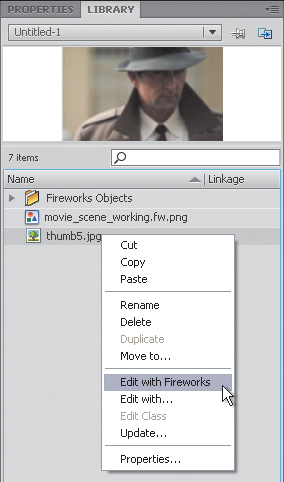Importing a flattened bitmap
Standard bitmap objects are easily imported into Flash.
1. | Choose File > Import > Import To Library.
| 2. | Browse to the Lesson13 folder and select thumb5.jpg.
Because this is a flattened image, no dialog box appears. The image is just directly imported into the Library.

Bitmap objects cannot be edited within Flash,
but this is where Fireworks comes in handy. Flattened objects like this
image can benefit from the other Flash/Fireworks integration feature,
round-trip editing.
| 3. | Right-click (or Control-click) on the image name in the Library panel.

| 4. | Choose
Edit With Fireworks. If it doesn’t say Edit With Fireworks, then choose
Edit With, navigate to where Fireworks is located, and open it that
way. From then on, it will say Edit With Fireworks, as expected, here.
The Find Source dialog box may appear and you will be asked if you want
to edit this image directly or locate a PNG file to make the edits.
| 5. | There is no PNG file for this image, so click the Use This File button.

The image opens in Fireworks, and above the document window you see a Done button and the phrase Editing From Flash.

| 6. | In
the Properties panel, click the Add Live Filters button (+) button to
add a Live Filter. Choose Shadow And Glow > Inner Shadow.

| 7. | Click the Done button.
Fireworks prompts you to save a PNG version of the image, because you
have added a Live Filter. As this change will be a permanent one to the
JPEG file, it would be wise to create a PNG image that can be edited
later.

| 8. | Click Yes, and save the file as thumb5.fw.png in the Lesson13 folder. This way, you can always further edit the Live Filter at a later time.
You are returned to Flash, where the thumb5.jpg image has been updated with the inner shadow.

From this point forward, if you need to make further edits to this
image, choose Use A PNG from the Find Source dialog box. In this manner,
you are not constantly editing and resaving a JPEG file, thus reducing
its quality each time.
| 9. | Close the Flash file without saving it.
|
Here are some factors to keep in mind when importing to Flash:
HTML: Pop-up menu code is not supported by Flash. Likewise, interactivity and button behaviors are not imported to Flash. Vectors and text:
Flash does not support all the special effects, fills, and strokes
available in Fireworks. When you import a Fireworks PNG file and choose
to keep the file as editable as possible, these features may look
different. Flash supports only solid fills, gradient fills (except the
contour gradient), and basic strokes. Bitmaps:
When Fireworks graphics are imported or copied and pasted into Flash,
some attributes are lost, such as certain Live Filters and textures. Graphic symbols with 9-slice scaling are supported in Flash, but 9-slice scaling is not maintained for animation symbols. Drag and drop:
You can drag and drop selections from the Fireworks Canvas directly on
the Flash stage. The import dialog box will appear when you release the
mouse so that you can control how the objects are imported into Flash.
|